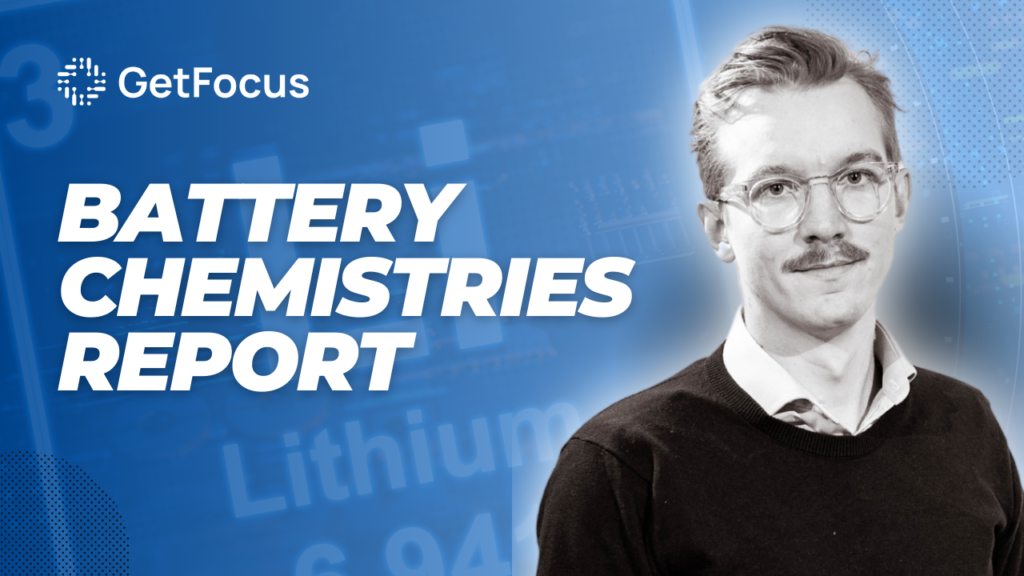
Automotive Industries interview with Jard van Ingen, CEO of Focus – The State of Charge – A Focus Report into the Future of Battery Chemistries
The automotive industry is on the cusp of a transformative era as electric vehicles (EVs) steadily become the new norm. Amidst this electrifying transition, the choice of battery technology looms large, dictating the range, charging speed, and overall performance of these futuristic automobiles. In a groundbreaking report titled “The State of Charge,” Focus, the world’s first predictive AI analysis platform, explores the current landscape of battery chemistries and forecasts the technologies that will shape the future of EVs.
In an exclusive interview with Jard van Ingen, CEO of Focus, we delve into the key findings of the report and unravel the intricate dynamics of the evolving battery technology ecosystem. The report signals a crucial turning point, predicting a continued dominance of traditional lithium-based batteries in the short term while shedding light on emerging alternatives like sodium-ion and the game-changing potential of graphene and dual-ion batteries.
Van Ingen begins by emphasizing the staying power of lithium-ion batteries, particularly the promising advancements observed in lithium-iron-phosphate batteries. These improvements encompass energy density, lifespan, charging speed, and cost reduction. Lithium-iron-phosphate batteries, classified as Technology Readiness Level (TRL) 7+, exhibit a slightly faster rate of improvement compared to other lithium-based chemistries, making them the frontrunners for affordable EVs in the near term.
Contrary to the buzz surrounding solid-state lithium batteries, the report pours cold water on their prospects. Despite being hailed as the next big leap in battery technology, solid-state lithium is deemed to underdeliver, facing challenges in development and improvement speed compared to competing alternatives like silicon anodes.
However, the spotlight of the report is undeniably on graphene batteries. The findings highlight graphene’s remarkable potential, exhibiting consistent and disruptive improvements at an astonishing rate of approximately 50% year-on-year. According to Van Ingen, graphene batteries have the potential to revolutionize the EV landscape by offering superior benefits across the board—ranging from increased energy density and faster charging to enhanced safety and extended cycle life.
The only roadblock for widespread adoption of graphene batteries lies in production costs. The report forecasts that graphene production will reach lithium cost parity in the early to mid-2030s, signaling a tipping point for economic viability. Once production costs drop significantly, graphene batteries are poised to become the frontrunners for the next era of EV technology.
Van Ingen sheds light on the methodology employed by Focus, which combines the power of large language models (LLMs), vector search, and multivariate regression. The use of LLMs enables continuous research into global patent data archives, providing valuable insights for tech scouting and comparisons. Vector search offers real-time intelligence from the global innovation landscape, while multivariate regression serves as the ‘oracle,’ predicting the rate of improvement for competing battery chemistries based on patent citation networks.
Human overview validates AI insights, ensuring accuracy and enabling near-infinite scaling of human expertise. This methodology forms the backbone of ‘The State of Charge’ report, offering a comprehensive analysis of Technology Readiness Levels (TRLs) and the Technology Improvement Rate to gauge the maturity and performance of various battery chemistries.
With automakers investing trillions in EV development, Van Ingen acknowledges the challenges they face in aligning their R&D strategies with the rapidly evolving battery landscape. The multitude of emerging technologies poses a dilemma for automakers, and Focus’s methodology aims to bridge the gap by providing a sneak peek into the future, helping them make informed decisions about where to channel their investments.
The interview concludes with a discussion on the role of government offices in collaboration with industry leaders. Van Ingen envisions a future where the adoption of Focus’s methodology by industry players and policymakers accelerates technological progress. By strategically shaping policies based on insights from ‘The State of Charge,’ governments can play a pivotal role in fostering the development and adoption of cutting-edge battery technologies in the transportation sector, contributing to a more sustainable and efficient future.
In the fast-paced race toward an electrified transportation future, ‘The State of Charge’ report serves as a compass, guiding industry leaders, policymakers, and enthusiasts through the complex terrain of battery technologies, ultimately steering them toward a greener and more innovative tomorrow.
Automotive Industries interview with Jard van Ingen, CEO of Focus
Automotive Industries: Hi Jard, can you provide a brief overview of the key findings from ‘The State of Charge’ report and its significance in shaping the future of battery technologies for electric vehicles?
Jard van Ingen: Very shortly summarized, lithium-ion batteries are here to stay for a number of years. Silicon anodes will likely extend their lifetime and make them more or less competitive with what solid state batteries have been promising but have so far not delivered on. We are skeptical about the competitiveness of solid state, and are very optimistic about graphene batteries.
Our report can help organizations with R&D activities in the EV space make better investment decisions.
Automotive Industries: The report mentions over a dozen emerging battery chemistries in the EV sector. Could you highlight a few of these emerging technologies and their potential impact on the electric vehicle industry?
Jard van Ingen: The most interesting chemistry to us is graphene batteries. Graphene batteries offer incredible potential and are improving very rapidly according to our metrics. They show clear signs of disruptive potential. Typically, technologies that improve significantly faster than their competitors and do so consistently are technologies that end up being disruptors. Graphene batteries clearly fall into that category.
For the EV industry, graphene could usher in all sorts of benefits for vehicle owners. Improved range, faster charging, increased cycle life, better safety and more.
Automotive Industries: The report suggests that lithium-based batteries remain the most viable in the near term. Could you elaborate on the improvements observed, particularly with lithium-iron-phosphate batteries, and how they compare to other lithium-based chemistries?
Jard van Ingen: We see a slightly higher rate of improvement in lithium-iron-phosphate batteries than in other lithium-based chemistries. These improvements revolve mainly around energy density, lifespan, charging speed, and cost reduction. Other lithium-based chemistries still offer superior energy density and thus range, but lithium-iron improvements are enabling cheaper EV’s in the short term.
Automotive Industries: Despite the hype, the report notes that solid-state lithium underdelivers. What challenges does solid-state lithium face, and do you see a realistic path for it to catch up and become a dominant battery chemistry in the future?
Jard van Ingen: The problem with solid state battery technology is that it is improving slightly slower than silicon anode technology. Silicon anodes promise roughly the same energy density when combined with lithium-ion technology as solid state does. Yet, solid state is behind in terms of development. A technology that is behind and is improving slower than competing alternatives will have a hard time catching up. Generally speaking, we do not see dramatic shifts in improvement speeds, therefore the future of solid-state batteries for EV’s looks bleak.
Automotive Industries: Graphene and Dual-Ion battery chemistries are highlighted for their rapid improvement. What specific advantages do graphene batteries offer, and how do you foresee their role in reshaping the electric vehicle landscape?
Jard van Ingen: Graphene batteries offer benefits on all fronts. Higher energy density and thus more range, better charging speeds, higher cycle life, safety improvements, etc. Their main drawback now is cost. The production cost for graphene itself needs to come down by more than an order of magnitude to make it cost effective. Graphene production cost is coming down pretty fast and once it has done so sufficiently, we think graphene will find widespread adoption due to the aforementioned benefits.
Automotive Industries: The report predicts that graphene production will reach lithium cost parity in the early to mid-2030s. What factors contribute to this forecast, and how might the economic viability of graphene batteries influence the market dynamics?
Jard van Ingen: The factors contributing to this forecast are the current price of graphene production (which is based on statements made by Rice University) and the rate of improvement in graphene production (which we estimate using our forecasting methodology). The rate of improvement for graphene production is about 36.5%. Based on these two inputs we estimate the production cost of graphene to drop to cost parity with lithium around 2030.
Automotive Industries: Could you delve into the methodology used by Focus, particularly the role of large language models, vector search, and multivariate regression, in providing insights for ‘The State of Charge’ report? How do these technologies work together to analyze global patent data?
Jard van Ingen: Firstly, we use large language models to scout for technologies, in this case battery chemistries that are emerging in the EV space.
Vector search is used to map out the landscape of patents that makes up the developmental history of each competing battery chemistry.
In addition, Multivariate regression is then used to estimate the rate of improvement for the competing battery chemistries based on indicators hidden in the citation network between patents. We know these indicators predict a certain rate of improvement because this has been verified on empirical measurements of technological improvement in the past.
Automotive Industries: Considering the substantial investments automakers are making in electric vehicles and batteries, what challenges and opportunities do they face in aligning their R&D strategies with the rapidly evolving battery technologies highlighted in the report?
Jard van Ingen: Because there are so many competing technologies out there, it is hard for automakers to pick winners. Generally, all emerging technologies have serious flaws. The hard part is to predict which emerging technology will solve these flaws the fastest such that it can become competitive. With our methodology we can fill in this blind spot, thus allowing automakers a sneak peek into the future.
Automotive Industries: How can government offices collaborate with industry leaders, using insights from the ‘State of Charge’ report, to shape policies that promote the development and adoption of cutting-edge battery technologies in the transportation sector?
Jard van Ingen: Our mission is to accelerate technological progress. We think it is possible to spot winning technologies very early on using our methodology. If industry leaders and policymakers start adopting our methodology, we can all make sure that R&D investments go into the right place. If we do this correctly, we can accelerate progress in the development, scaling, and adoption of technologies that would win regardless.









More Stories
Meet Rita Case – recipient of 2024 NAMAD Lifetime Achievement Award
How Much Can You Save Annually by Switching to Energy-Efficient Rotary Solenoids
TTI IP&E – Europe supporting the logistics and engineering of IP&E components